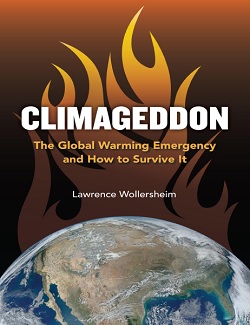|
TRANSLATE THIS ARTICLE
Integral World: Exploring Theories of Everything
An independent forum for a critical discussion of the integral philosophy of Ken Wilber
"The Dirty Secrets Behind The New Paris Climate Conference (COP21) Agreement They Don't Want You to Know" How Did We Waste 30 Years of Warnings About Escalating Global Warming?Climageddon, Part 1, Chapter 7Lawrence WollersheimOverview:
Before moving on to the last two chapters of Part 1 or exploring the global warming solutions found in Part 2, it is wise to examine how we have wasted so much valuable time and put ourselves into this untenable State of Emergency. This way, we have a better opportunity to resolve the issue and avoid the same mistakes. There are many reasons why we have ignored over 30 years of valid warnings about the consequences of escalating global warming. A key reason is because the recognized world authority on global warming, the IPCC, has failed to adequately inform us as to the real risk and urgency of our crisis.[89] Before discussing the numerous problems with the IPCC's global warming information and predictions, it is necessary to frame the challenge to the IPCC's reports appropriately. In the criticisms below, we are not in any way criticizing the thousands of climate scientists, many of whom at their own expense provide uncensored, accurate, and up-to-date global warming research to the IPCC's bureaucrats. However, those IPCC bureaucrats are the individuals who, through a highly constrained administrative process, create the final reports and predictions. What follows also does not question the good intentions of the constrained IPCC bureaucrats caught in the slow and conservative bureaucracy of an international entity, which must not only seek member consensus and funding, but also avoid panicking the public. Additionally, do not misconstrue the following criticism of the IPCC's bureaucratic process results in any way as a criticism of the underlying valid science of global warming being presented by the thousands of climate scientists contributing their research to the IPCC reports or the vast 97 percent[90] consensus of climate scientists who, as a whole, agree that global warming has human causation and one of the largest human causes is the burning of fossil fuels. Now that you have this background, let's look at the IPCC problems. In their 5-7 year climate update reports and predictions for politicians and policymakers, the IPCC has a repeated history of significantly underestimating how much of a problem global warming could become, as well as its time frames.[91] Before expanding upon the IPCC's climate data underestimation problem, it is essential to understand how they create their 5-7 year global warming and prediction scenario updates for the world's politicians and policymakers. What surprises many individuals is that the IPCC itself does not do original global warming research. Working as unpaid volunteers, thousands of scientists from around the globe sift through the most current scientific literature on global warming and the climate. After completing this review, these unpaid scientists identify trends, write a draft report, and submit it to the IPCC. Next, the IPCC reviews the submitted research from these scientists. This typically takes five to seven years to complete. Then, in a tediously slow and bureaucratic process, the IPCC creates comprehensive reports and assessments, including global warming prediction scenarios. Then, in the near to last step, other scientists once again take the assembled draft and review and revise it as needed. Finally, a summary for national politicians and policymakers is written. This condenses the science even further. This new and final summary report is then subjected to a line-by-line review and possible revision by non-scientist national representatives from more than 100 world governments—all of whom must approve the final summary document before it is signed and presented to the public. Now that you understand the process for how the IPCC creates its reports, the following will not seem so surprising. A growing number of studies (referenced elsewhere,) claim that across two decades and thousands of pages of IPCC climate reports, the IPCC has consistently understated the rate and intensity of global warming, as well as the danger that it represents.[92] Since the IPCC 2007 assessment, these studies have shown that the speed and ferocity at which the climate is destabilizing are at the extreme edge of, or are outpacing, IPCC projections on many fronts, including temperature rise, carbon emissions, sea level rise, continental ice-sheet melt, Arctic sea ice decline, ocean acidification, and thawing tundra. One glaring example of IPCC underestimation can be found in the IPCC's previous 2007 report[93] that concluded the Arctic would not lose its summer ice before 2070 at the earliest. But the ice pack has shrunk far faster than any scenario IPCC scientists felt politicians and policymakers should consider. Just a few years after that report, a new study predicted that by 2016- 2020, the Arctic's Northwest Passage will be completely ice-free during the summers. This means that in 2007, the IPCC was off by an incredible 50-54 years on a key climate prediction over an estimation prediction period of only 63 years! Another glaring example of the dangerous IPCC underestimation problem surfaced from James Hansen, the former NASA scientist who originally warned the world about global warming nearly 30 years ago. Hansen's new study says sea levels could rise by as much as 10 feet (3 meters) by 2050. The IPCC has repeatedly and consistently predicted that sea levels should rise only 3 feet (0.9 meters) by 2100. That's a 60-70% underestimation by the IPCC occurring 50 years earlier! Over its history, the IPCC's global warming consequence and timetable scenario predictions are regularly underestimated by anywhere from 25 to 40%. Why the IPCC's global warming underestimation problem is critical to you, your business, and your nation's futureAll underestimation by the IPCC is dangerous. First, because the organization is treated as the most recognized authority on global warming and is charged with advising national politicians and policymakers on the most relevant and accurate climate science so they can make the necessary laws and policy changes to keep us safe. Next, the IPCC's overly conservative reading and underestimation problems means that national governments, businesses, and the public will be grossly unprepared and blindsided by the more rapid onset of higher flooding, extreme storms, drought, and other global warming impacts and consequences far beyond what they are currently prepared for.[94] Worse yet, a society blind to the full range and speed of potential global warming outcomes can remain unconscious of or apathetic to the growing emergency, causing them to push the hard but necessary global warming reduction decisions farther and farther off into the future. Probably the greatest loss caused by IPCC's underestimation problem is that it quells, if not removes, the appropriate sense of urgency essential to motivating the world and its nations to deal with escalating global warming's present and future threats. For example, what if the global warming disasters projected by the IPCC to start arriving in 2060-2080 begin in 2030-2040? If that happens, we won't be prepared for the true scale, severity, and frequency of the disasters to come. (Graphs shown below in the underestimation correction section will help you visualize what this means in shortened time frames.) Conflicts of interest and the IPCC's underestimation problemBecause the IPCC's final summary report is subjected to a line-by-line review/revision by representatives from more than 100 world governments, all of whom must individually approve and sign off on the final summary document before it is presented to the public, it is only reasonable to consider that inherent national conflicts of interest will also act to water down, delay, or delete those sections of each global warming report that directly and significantly impact the overall military, security, economics, or other key well-being factors of the sign-off nation. For example, countries like Venezuela, Saudi Arabia, Iraq, Russia, the United States, United Arab Emirates, Kuwait, and Iran have huge portions of their annual gross domestic product (GDP) dependent upon producing and/or exporting fossil fuels. If there were a sudden and significant mandated reduction in use of global fossil fuel, some of these countries, particularly the ones with large national debts or without large financial reserves like Russia, Venezuela, the United States, Iraq, and Iran, could plunge into rapid economic decline and in some cases, possibly even social and political unrest or collapse.[95] Unless something shifts radically, these serious conflicts of interest in sign-off nations will be a continuous source of watered-down or missing key facts. The IPCC's most fatal flaw and shockerThe previously mentioned underestimation problems with the IPCC are not even its worst global warming data integrity problem. It also has a problem with its global warming tipping point education and disclosure scenarios. To fully appreciate how important that fatal flaw is, it is necessary to review a bit of basic logic. There is a principle in logic that if all or a significant part of the foundational premise upon which you build a theory or solution is insufficient or false, the consequent theory or solution created will also be insufficient or false either in total or to a significant degree. Keep this principle of logic in mind as there is a giant data analysis fatal flaw in the premise upon which the IPCC builds its global warming risk analysis for its global warming consequence prediction scenarios and timetables. To many individuals who are well-informed about global warming, this lack of cognizance by the IPCC about this second tipping point issue is seen as the one fatal flaw that will most quickly force us unknowingly into the later phases of the Climageddon Scenario. Let's review the four newest global warming prediction scenarios provided in 2014 by the IPCC to the world's politicians and policymakers. It will provide foundational evidence for the biggest flaw in the IPCC's global warming risk analysis process and consequence prediction scenarios. The following four global warming prediction scenarios of the IPCC are based on the assumption that we have no major climate system surprises such as going over more global warming tipping points. Those predictions are:
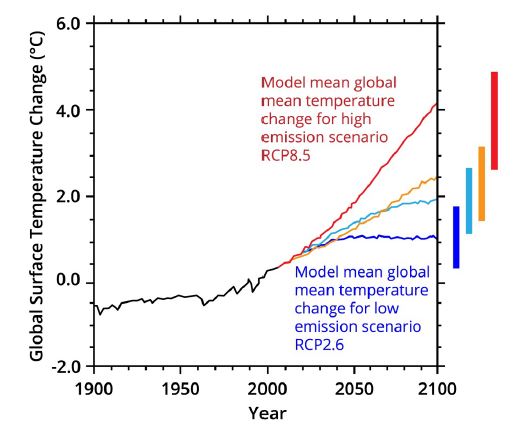
This graph shows four different trajectories for greenhouse gas
concentrations. These representative concentration pathways
(RCPs) show four potential climate futures. The lowest pathway,
RCP2.6 (the bold blue line) shows an average global temperature
increase of 1° Celsius. The highest pathway, RCP8.5, shows an
average increase of 2.0° to 3.7° Celsius. Source: IPCC, 2013, FAQ
12.1, Figure 1.[96]
From each of the four IPCC prediction scenarios, what is missing and what has been unwisely omitted is the essential inclusion of tipping point calculations. The IPCC's four prediction scenarios rest on the assumption that we will never go over any global warming tipping points in any of the climate's major or minor systems or subsystems. Planning for everything going perfectly is the perfect plan for failure! In effect, what the IPCC has done is to all but remove or ignore highimpact, often unrecoverable global warming, climate, human, and biological system tipping point variables that should have been included in an accurate and complete risk spectrum analysis. Without including and considering these critical high-impact tipping point consequence events in their master risk analysis, the IPCC has not met the minimum essential data inclusion threshold necessary to create a valid and complete global warming risk analysis that could be used to properly inform our politicians and policymakers, as well as the general public, of all real and significant current and future risks and timetables their nations and people face. 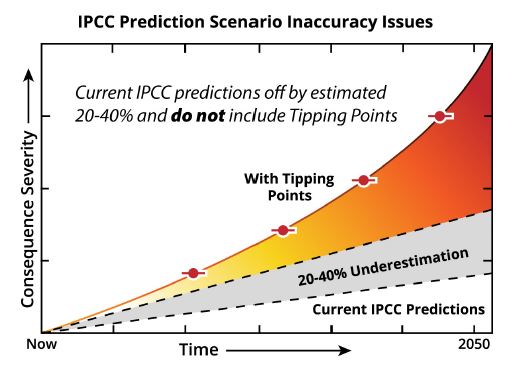 Correcting for the underestimation in the current IPCC temperature projectionsIt is useful to now update the IPCC's four most recent 2014 average global temperature and time frame predictions (listed previously) while compensating for their regular underestimations of about 25-40%. Please keep in mind the IPCC's 2014 prediction scenarios also do not include any calculations or adjustments for crossing more global warming tipping points during their prediction scenario periods. Here is what the IPCC's temperature and arrival date estimates might look like if their underestimation bias were corrected: 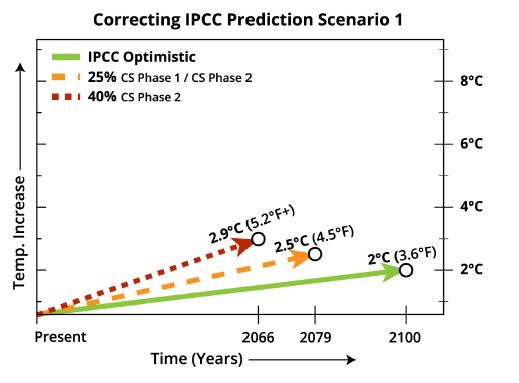 In IPCC Scenario 1, their most optimistic projection, they say we will have only a 2° Celsius increase by 2100 (3.6° Fahrenheit). (Please note that in all 4 graphs below, CS stands for Climageddon Scenario and the 25% and 40% are underestimation correction levels for the 4 IPCC prediction levels.) At the 25% underestimation level, this means that we will reach 2.5° Celsius (4.5° Fahrenheit) about 21 years sooner than they predict will occur—at about 2079. This puts us in the later part of Phase 1 of the Climageddon Scenario, or more likely, in the beginning of Phase 2. At the 40% underestimation level, we will reach 2.9° Celsius (5.2° + Fahrenheit) roughly 34 years sooner than they predict—at about 2066. This puts us somewhere within Phase 2 of the Climageddon Scenario. 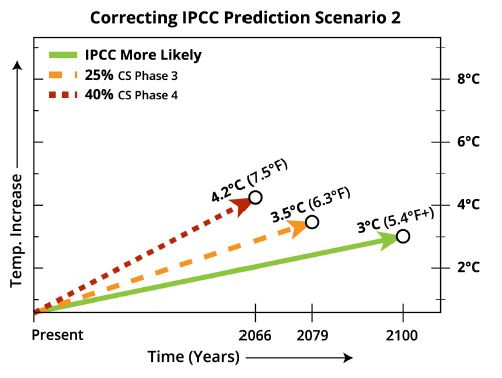 In IPCC Scenario 2, their more likely projection, they say we will have only a 3° Celsius increase by 2100 (5.4° Fahrenheit). At the 25% underestimation level, this means we will reach 3.5° Celsius (6.9° Fahrenheit) about 21 years sooner than they predict —at about 2079. This puts us in or near Phase 3 of the Climageddon Scenario. At the 40% underestimation level, we will reach 4.2° Celsius (7.5° Fahrenheit) about 34 years sooner than they predict—at about 2066. This puts us in or near Phase 4 of the Climageddon Scenario. 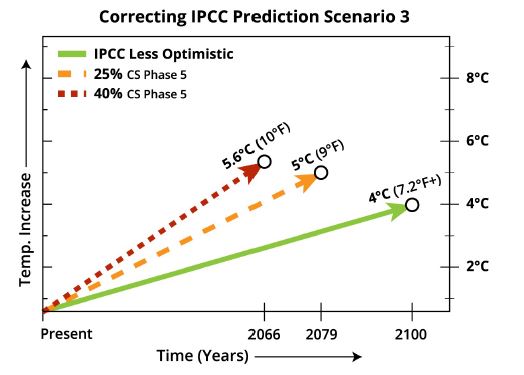 In IPCC Scenario 3, their less optimistic projection, they say we will have only a 4° Celsius increase by 2100 (7.2°+ Fahrenheit). At the 25% underestimation level, this means we will reach 5° Celsius (about 9° Fahrenheit) 21 years sooner than they predict —at about 2079. This puts us in or near the chaos and collapse of Phase 5 of the Climageddon Scenario. At the 40% underestimation level, we will reach 5.6° Celsius (10° Fahrenheit) 34 years sooner than they predict—at about 2066. This also puts us in or closer to phase 5 of the Climageddon Scenario. 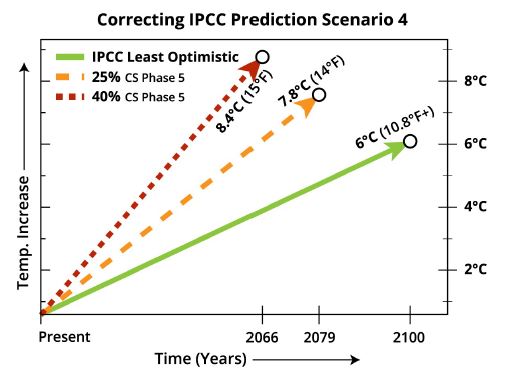 In IPCC Scenario 4, their least optimistic projection, they say we will have only a 6° or more Celsius increase by 2100 (10.8°+ Fahrenheit). A 6° Celsius increase in average global temperature is the end of most human life as we know it. At the 25% underestimation level, this means that we will reach 7.8° Celsius (about 13.5° Fahrenheit) at about 2079. This will put us well into Phase 5 of the Climageddon Scenario. At the 40% underestimation level, we will reach 8.4° Celsius (about 15° Fahrenheit) —at about 2066. This could put us in Phase 5 of the Climageddon Scenario faster than anyone is ready for. (Please note: In the four corrected IPCC graphs above, we are using recalculated temperature estimates to extrapolate approximate placement positions for the graph's new projected time lines. Rather than show the precise new time frames of a particular recalculated temperature, these four graphs illustrate relative differences from the IPCC's predicted temperatures and time frames. These four graphs additionally point toward how unanticipated higher temperatures will also drastically accelerate consequence arrival times and increase consequence severity. It is difficult to precisely recalculate new timeframes with temperature calculations only, and because there is always a delay in the actual time that it takes to get to higher temperatures because of inertia and momentum factors in climate systems and subsystems.) What can we doThe IPCC's underestimation presents an absolute nightmare for anyone trying to do long-term planning, whether it be personal, business, local, regional, or national. When we take into account the IPCC underestimations and come up with new temperature and timetable predictions, it appears any mid-term to long-term future planning based on the IPCC's predictions will put us in a world of hurt. When we reach 5 to 6° Celsius (9-10.8° Fahrenheit) it will be the end of the world as we know it and, as you can see from the above data, it is not far off in the future. When you factor in crossing more global warming tipping points (which is highly probable and which was completely absent from the IPCC predictions and is also not included in the graph calculations above), our world is in serious peril, not 40 or 80 years from now, but right now and over the next 20-40 years. It is illogical beyond all comprehension to assign full responsibility for evaluating and predicting the single greatest security threat of the 21stcentury to a group of volunteer and underfunded climate scientists who submit their research to an bureaucratic and underfunded United Nations agency. But who should be doing this work? If not the IPCC, who is most qualified to do needed tipping point research and prediction?It is clear the IPCC is not doing its job. The world's current leading authority on global warming is no longer the appropriate agent we can trust to manage the research, analysis, and planning necessary to save us from the escalating global warming emergency. The danger is so great and imminent that we can't keep doing the same thing over and over, expecting a different result. We have no other rational choice but to bypass any existing failed authorities, structures, and processes that have not worked and are not working. That is the only way we will have any honest hope of handling the global warming emergency. Part 2 of this book will tell you who should be doing this research and prediction work. Other reasons for 30 years of failureThere are many other contributing reasons for why we have failed to resolve the global warming crisis over the last 30 years, but a major reason lies within the data we've been given and the organization trusted to give us that data. More of these other contributing reasons will be revealed in later chapters. A deeper dive into the science of the IPCC's prediction underestimation issuesFor those who want to go into more detail, Climate Interactive's scoreboard[97] provides a helpful visualization of the mess the IPCC has created. Not including any tipping point scenarios, this scoreboard will further illustrate where average global temperature is headed using the IPCC's current underestimated and uncorrected calculations. What's nextThe next chapter contains some of the most challenging information of this book. It discusses other problems and dilemmas we must overcome to be successful in preventing the later extinction level stages of the Climageddon Scenario. Unfortunately, there is another serious IPCC error that significantly reduces the reliability of the predicted times, temperatures, and results of the IPCC's four prediction scenarios listed earlier. A professor of atmospheric sciences discovered this while developing a predictive formula for how either maintaining or growing the world's economy directly relates to atmospheric carbon levels. This formula and the unsettling research behind it is better described within the context of the next chapter. In case you are wondering: if not the IPCC, who will do this work correctly? The best answer for that question will be disclosed in Part 2 of this book. Summary
NOTES[89] Glenn Scherer. "How the IPCC Underestimated Climate Change." Scientific American. December 6, 2012. www.scientificamerican.com [90] "Scientific consensus: Earth's climate is warming." Climate.Nasa.Gov. Last modified January 24, 2017. climate.nasa.gov [91] Dana Nuccitelli. "Vision Prize: scientists are worried the IPCC is underestimating sea level rise." The Guardian. February 18, 2014. www.theguardian.com [92] Bill McKibben. "The IPCC is stern on climate change - but it still underestimates the situation." The Guardian. November 2, 2014. www.theguardian.com [93] Solomon, S., D. Qin, M. Manning, Z. Chen, M. Marquis, K.B. Averyt, M. Tignor and H.L. Miller, eds., "Contribution of Working Group I to the Fourth Assessment Report of the Intergovernmental Panel on Climate Change," (Cambridge: Cambridge University Press), www.ipcc.ch [94] Chris Mooney. "The world's climate change watchdog may be underestimating global warming." The Washington Post. October 30, 2014. www.washingtonpost.com [95] Nicholas Stern. "Economics: Current climate models are grossly misleading." Nature.com. February 24, 2016. www.nature.com [96] FAQ 12.1, Figure 1, from Collins, M., R. Knutti, J. Arblaster, J.-L. Dufresne, T. Fichefet, P.
Friedlingstein, X. Gao, W.J. Gutowski, T. Johns, G. Krinner, M. Shongwe, C. Tebaldi, A.J. Weaver
and M. Wehner, 2013: Long-term Climate Change: Projections, Commitments and Irreversibility.
In: Climate Change 2013: The Physical Science Basis. Contribution of Working Group I to the Fifth
Assessment Report of the Intergovernmental Panel on Climate Change [Stocker, T.F., D. Qin, G.-
K. Plattner, M. Tignor, S.K. Allen, J. Boschung, A. Nauels, Y. Xia, V. Bex and P.M. Midgley (eds.)].
Cambridge University Press, Cambridge, United Kingdom and New York, NY, USA.
|
